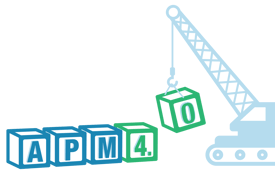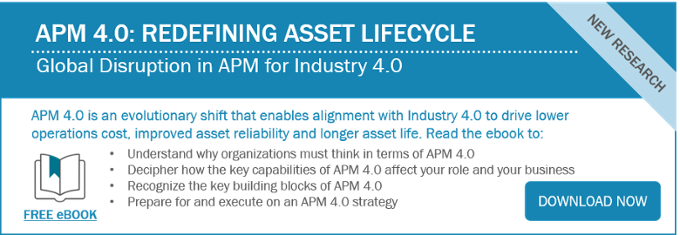Every year LNS analysts offer up our predictions on what the year will bring in each of our coverage areas. In 2018 the most significant shift in APM will be the move away from the maintenance-centric approach that APM was born from 15-20 years ago including enterprise asset management (EAM), computerized maintenance management systems (CMMS) and a focus on reliability and downtime reduction to APM 4.0. APM 4.0 with the emphasis on Digital Twins and prescriptive analytics is more about asset optimization than just reliability and availability.
Click here to speak with Dan Miklovic
 Even though the percentage of industrial companies that do traditional APM with strong reliability programs is still less than 50%, it is growing. The real dialogue is shifting - most businesses are now using condition-based maintenance (CBM) for their most expensive and critical assets. We have noticed that forward-thinking companies aren't just focused on uptime; they view assets holistically with the objective to obtain maximum value over each asset’s entire lifecycle.
Even though the percentage of industrial companies that do traditional APM with strong reliability programs is still less than 50%, it is growing. The real dialogue is shifting - most businesses are now using condition-based maintenance (CBM) for their most expensive and critical assets. We have noticed that forward-thinking companies aren't just focused on uptime; they view assets holistically with the objective to obtain maximum value over each asset’s entire lifecycle.
Because of this, companies will pursue the following trends with greater vigor in 2018:
- Artificial intelligence (AI) and machine learning (ML) get applied to operational performance
- Digital Twins incorporate more “what-if” capabilities
- Autonomy starts to show up on the shop floor in maintenance
- Mergers and acquisitions (M&A) in APM intensifies while new entrants continue to enter the market
It’s About the Business
Ever since the advent of APM, the focus has been on improving reliability, decreasing downtime and reducing unplanned maintenance. Most of this has been predicated on the premise, "If it's broken it can’t be contributing to the business". There is the assumption that minimizing downtime improves profitability and the best way to reduce downtime is to “fix” equipment before it fails catastrophically. The problem with this assumption is that the act of maintaining a piece of equipment can, by itself, cause further failures. In the past, analytics have been used to predict when a piece of equipment will fail and then doing preventative maintenance.
However, we see a shift in focus towards optimizing the profitability from equipment in 2018. Machine learning and better Big Data analytics will enable a business to decide the best operating profile for the plant based on order backlog, reliability issues and the Digital Twin model of the plant. In 2017 we saw the introduction of these concepts with Schneider Electric’s “profit advisor” solutions and GE’s operational performance management (OPM) products, among others. Expect more in 2018 from suppliers like Aspen Technology and Honeywell.
Digital Twin Simulates Possible Futures
Just as with the focus of analytics, much of the hype around Digital Twin in asset-intensive industries has been about maintenance-focused applications like superimposition of operating conditions on virtual x-rays of the equipment to aid technicians in using the twin to model expected service life. The twin has been the basis for the growth of augmented reality (AR) and virtual reality (VR) tools to help technicians perform service tasks better. In 2018 we expect the Digital Twin to include physical aspects of the twin as well as the process aspects. This shift in focus will drive new interest in process design and engineering applications, so changes required to facilitate reliability in operating performance can reveal production impacts. This expanded use of Digital Twin to provide alternative future states and make recommendations as to a possible course of actions will change the concept of what a Digital Twin is.
Autonomous Devices Supporting APM
The end game for “smart connected assets” is an autonomous operation, but LNS still sees that as an aspirational goal. In 2018, we will see more robots and other process systems behaving autonomously. Some of the examples might be relatively simplistic, such as floor cleaning robots on an industrial scale (think Roomba for the plant), or drones to survey large facilities for gas leaks. Going forward, robots will become more human compatible. Expect to see more autonomous inspection tools that monitor equipment performance and provide service without human intervention. In some industries like mining, we will see this sooner. The technical director for Anglo American Mining predicted that within five to seven years, many of its operations would run without humans at the ore face. BHP Billiton is already in the process of implementing autonomous ore trains in Western Australia. Other industries will follow, and 2018 will see significant experimentation in most forms of manufacturing.
APM Vendor Landscape Evolves
The last couple of years have seen some significant M&A deals in the APM sector like GE’s acquisition of Service Max, BitStew, and Meridium, Aspen Technology’s acquisition of Mtell and Fidelis Group, and Aptean's acquisition of AssetPoint. Perhaps the most massive deal in the APM world will be the consummation of the Schneider Electric software element and AVEVA expected in the first quarter of 2018. At the same time there are numerous startups all doing interesting and exciting work in predictive analytics, AR/VR enabled information display in support of mobility, drones for asset surveying and many other areas. With APM 4.0 demanding a robust set of capabilities many of the more significant players will resort to outsourcing their R&D by acquiring some of these more innovative firms. We expect the pace of M&A to pick up in 2018 after the slight slowdown in late 2017. So, don’t be surprised if you hear of lots of money pouring into the APM space as everyone rushes to get their piece of the pie.
Come 2019, it will be interesting to see just how well LNS did with these predictions and if you haven’t already, read our self-assessment of our 2017 predictions.
